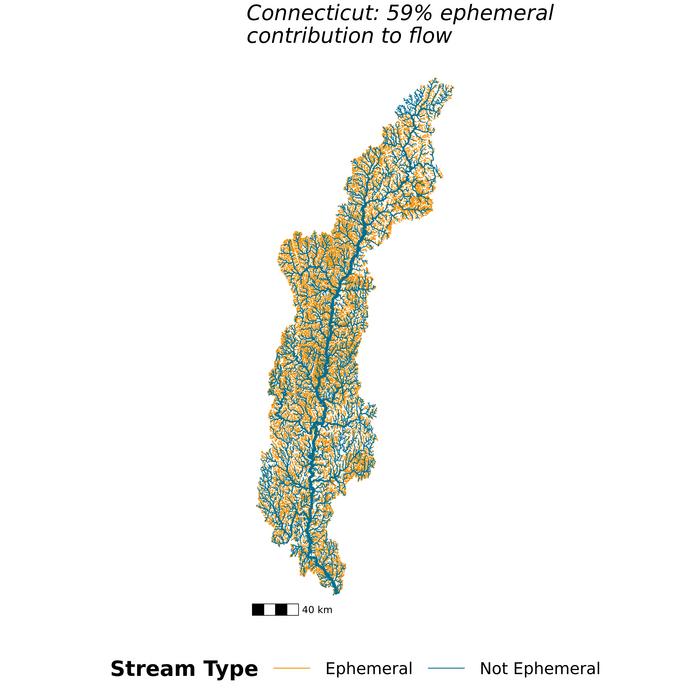EMBARGOED [embargo date 6/27 2pm eastern]

Credit: Craig B. Brinkerhoff
EMBARGOED [embargo date 6/27 2pm eastern]
AMHERST, Mass. – The Supreme Court ruled last year that rivers that only flow in response to weather events—called ephemeral streams—do not fall under the protection of the Clean Water Act. New research published in the journal Science, led by University of Massachusetts Amherst recent doctoral graduate Craig Brinkerhoff and co-authored by colleagues at Yale University, suggests that this now leaves many U.S. waterways vulnerable to pollution.
Consider the Connecticut River, says Colin Gleason, Armstrong Professor of civil and environmental engineering at UMass Amherst and an author on the paper. The Connecticut has rules regulating where and what kinds of sediments, nutrients and pollutants can be dumped into the river, “and if you now just go up into the hills and dump it in a dry gully… there’s every chance it ends up in the main stem of the Connecticut that you’ve worked so hard to protect once it rains,” he explains.
While perennial streams flow continually, an ephemeral stream does not contain groundwater, so these non-perennial streams only run when they fill up with rain.
The researchers set out to determine just how much water these sometimes-dry river beds contribute to a river system’s total output.
They found that, on average, ephemeral streams contribute 55% of the water that comes out of the mouth of regional river systems across the United States, but there is a strong east-west divide. River basins west of the Mississippi are more influenced by ephemeral streams than eastern rivers. For instance, 94% of the water coming out of the river systems in Black Rock Desert, Nevada, and Humboldt County, California, comes from ephemeral streams.
This makes sense, says Brinkerhoff. “Normally, when we think about ephemeral streams, we think of dry riverbeds in the desert,” he explains. “The groundwater table is always way below the land surface.”
But the researchers were surprised to discover just how influential these ephemeral streams were on the East Coast as well: “Even on the East Coast, even in a humid place where there’s a ton of groundwater, ephemeral streams are still exerting a big influence,” Brinkerhoff continues.
Gleason points to his home watershed to illustrate this point. “On a day in which every stream in the Connecticut River is flowing with its average annual condition, 59% of the water entering Long Island Sound was sourced from these ephemeral streams—a.k.a., dry gullies in the woods,” he says.
However, these ephemeral streams are no longer regulated by the Clean Water Act (CWA). Last summer, in the case of Sackett v. Environmental Protection Agency, a majority of the Supreme Court defined the bodies of water that fall under CWA protection as “only those relatively permanent, standing or continuously flowing bodies of water forming geographical features that are described in ordinary parlance as streams, oceans, rivers, and lakes.”
“The Clean Water Act regulates where and how much we can dump into water bodies—water bodies being rivers, lakes, wetlands, reservoirs, etc.,” says Brinkerhoff. And the implications of this new research for water pollution are clear: “[Ephemeral streams are] not flowing most of the time, but then you get a big enough rainstorm and all of a sudden you’re pushing the stuff that’s been accumulating in those rivers downstream. In theory, pollution in those ephemeral streams will ultimately influence water many kilometers away that is, at least nominally, still regulated by the Clean Water Act,” he says.
Doug Kysar, Joseph M. Field ’55 Professor of Law at Yale Law School, and one of the study’s authors, says that this work helps provide a constitutional basis to include ephemeral streams in the CWA. “Water pollution is a transboundary issue that clearly implicates interstate commerce, such that Congress could regulate ephemeral streams even if they are not the kind of ‘navigable waters’ that Congress has historically exerted federal authority over.”
However, he also says that it’s more likely that this responsibility will fall to state and local governments. “The irony is that the federal Clean Water Act was adopted precisely because state and local governments were thought to be doing a poor job of protecting the nation’s waterways,” he adds. “Our research helps to explain why that would be the case, as it shows just how far downstream from an ephemeral waterway the ultimate impacts of pollution can be felt. States don’t necessarily have incentives to adopt costly water protections when the benefits will be felt by ecosystems out of state.”
Using hydrology models, theory and field data, the researchers built a model that identifies every ephemeral stream in the contiguous U.S. and determines the percentage of a river’s flow (for its annual average condition) that came from these ephemeral streams.
One thing the researchers emphasize is that the size of the river basin used for their modeling does influence the results. The 55% figure is only true when you divide river basins into a certain size—if they had used smaller basins, the ephemeral influence would be larger, and if they used bigger basins, the influence would be less. But even using the scale they did—which is the second-largest river basin scale defined by the U.S. Geological Survey—ephemeral streams still influenced more than half of rivers’ total water output. In other words, 55% is a quite surprising finding for rivers so large, the researchers say. Previous thinking was that ephemeral streams only influence their immediate areas.
“Our study provides more concrete evidence that all of these things are connected,” says Brinkerhoff. “We can’t regulate water bodies ad hoc.”
Contact:
Craig Brinkerhoff, cbrinkerhoff@umass.edu
Julia Westbrook, jwestbrook@umass.edu 413-545-0149
IMAGE NOTE: Graphic mappings of ephemeral versus perennial streams are available for 205 different areas in the U.S. Please contact Julia to request your region.
Journal
Science
Method of Research
Computational simulation/modeling
Subject of Research
Not applicable
Article Title
Ephemeral stream water contributions to United States drainage networks
Article Publication Date
28-Jun-2024



